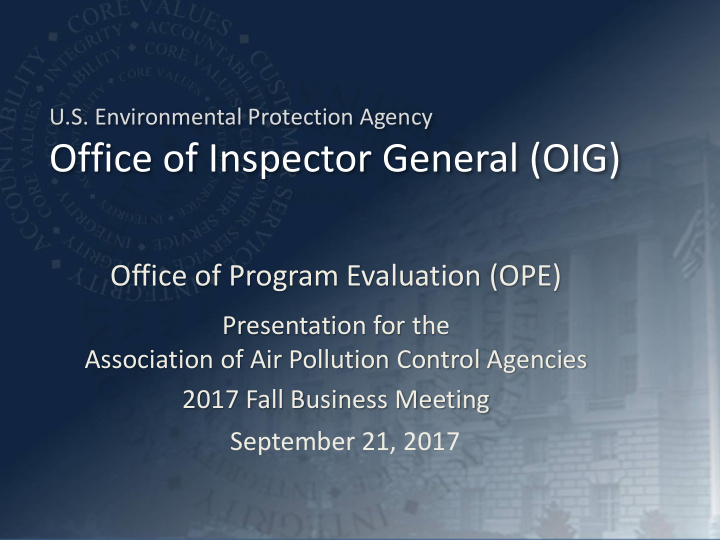



U.S. Environmental Protection Agency Office of Inspector General (OIG) Office of Program Evaluation (OPE) Presentation for the Association of Air Pollution Control Agencies 2017 Fall Business Meeting September 21, 2017
Agenda OIG Background OIG Organization Recent Reports Current Evaluations 2
OIG Background The OIG is an independent office within the U.S. Environmental Protection Agency (EPA) created pursuant to the Inspector General Act of 1978, as amended. Per the act, OIGs perform the following functions: Conduct and supervise audits and investigations relating to the programs and operations of their agencies. Review existing and proposed legislation and regulations relating to the programs and operations of their agencies. Provide leadership and coordination, and recommend policies for activities designed to promote economy, efficiency, and effectiveness and to prevent and detect fraud and abuse. Provide a means for keeping the head of the establishment and Congress fully and currently informed about problems and deficiencies and about the necessity for and progress of corrective actions. 3
OIG Organization Immediate Office of the Inspector General Inspector General Deputy Inspector General Office of Counsel Office of Office of Office of and Office of Audit Program Investigations Management Congressional Evaluation and Public Affairs 4
OPE Organization Assistant Inspector General Deputy Assistant Inspector General Air Water Toxics, Chemical Land Cleanup and Waste Management and Pollution Management Prevention Environmental Research Special Program Reviews Programs 5
Recent Reports 6
Recent Reports Certain State, Local and Tribal Data Processing Practices Could Impact Suitability of Data for 8-Hour Ozone Air Quality Determinations; February 6, 2017 Two monitoring agencies we reviewed adjusted ozone data prior to reporting it to the Air Quality System, and were not implementing critical criteria as recommended in the EPA’s Quality Assurance Handbook. About 26 percent of the 2012-2014 national hourly ozone data original recorded in AirNow were different from the ozone data reported to the Air Quality System. Presents risk that other air monitoring agencies were improperly adjusting their data, which could impact the quality of data used in EPA’s designation process. 7
Recent Reports Improved Data and EPA Oversight Are Needed to Assure Compliance With the Standards for Benzene Content in Gasoline; June 8, 2017 EPA Implemented Prior OIG Recommendations, but Additional Guidance Could Strengthen the Human Subjects Research Program; August 1, 2017 For information and access to all OIG reports https://www.epa.gov/office-inspector-general/oig-reports 8
Current Evaluations Review of Ambient Monitoring Data Changes and Gaps Objective: To determine whether selected air monitoring data in EPA's Air Quality System meet criteria established by EPA. Specifically, 1. Do data revisions comply with EPA criteria? 2. Do data exclusions or gaps comply with EPA criteria? Status: Drafting report 9
Current Evaluations EPA Efforts to Evaluate and Reduce Air Emissions from CAFOs Objective: Determine what actions EPA has taken to evaluate air emissions from Animal Feeding Operations (AFOs), including the status of EPA's National Air Emissions Monitoring Study (NAEMS) Status: Final report pending 10
Current Evaluations Effectiveness of EPA's Oversight of State Vehicle Inspection and Maintenance (I/M) Programs in Achieving Emission Reductions Objective: To determine whether EPA’s oversight has ensured that vehicle inspection and maintenance (I/M) programs are effective and efficient in reducing vehicle emissions in enhanced I/M areas. Status: Preliminary research 11
Current Evaluations EPA's Approval Process for Air Quality Dispersion Models Objective: To assess the effectiveness of EPA's process for reviewing and approving air quality dispersion models recommended for use by state , local and tribal air pollution control agencies. Status: Preliminary research 12
Current Evaluations EPA's Estimation of Methane Emissions From the Oil and Natural Gas Production Sector Objective: To determine: (1) How EPA estimates methane emissions from the oil and gas production sector, including the extent to which EPA has used the results of 2013 and 2014 emission studies conducted jointly by the EDF and UT-Austin to estimate those emissions, and 2) Whether concerns about technical or other problems with the EDF/UT-Austin studies were identified or brought to EPA's attention, and how EPA addressed and resolved any such concerns. Status: Preliminary research 13
More Information on the OIG https://www.epa.gov/office-inspector-general 14
OPE Contacts Carolyn Copper, PhD ▪ Assistant Inspector General for Program Evaluation ▪ Copper.Carolyn@epa.gov ▪ 202-566-0829 Christine El-Zoghbi, PhD ▪ Deputy Assistant Inspector General for Program Evaluation ▪ El-Zoghbi.Christine@epa.gov ▪ 202-566-2063 15
OPE Air Contacts James Hatfield, Director ▪ Hatfield.Jim@epa.gov ▪ 919-541-1030 Renee McGhee-Lenart, Project Manager ▪ McGhee-Lenart.Renee@epa.gov ▪ 913-551-7534 Erica Hauck, Project Manager ▪ Hauck.Erica@epa.gov ▪ 303-312-6629 Gabby Fekete, Project Manager ▪ Fekete.Gabby@epa.gov ▪ 919-541-3537 16
Recommend
More recommend